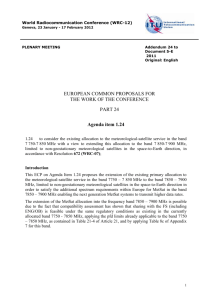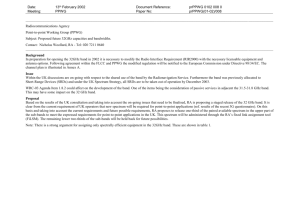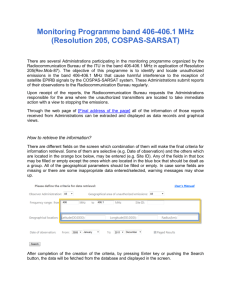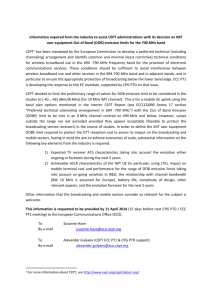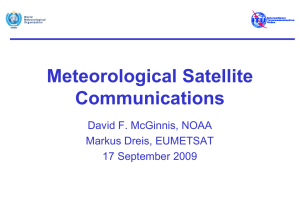Draft CEPT Brief on agenda item 1.24
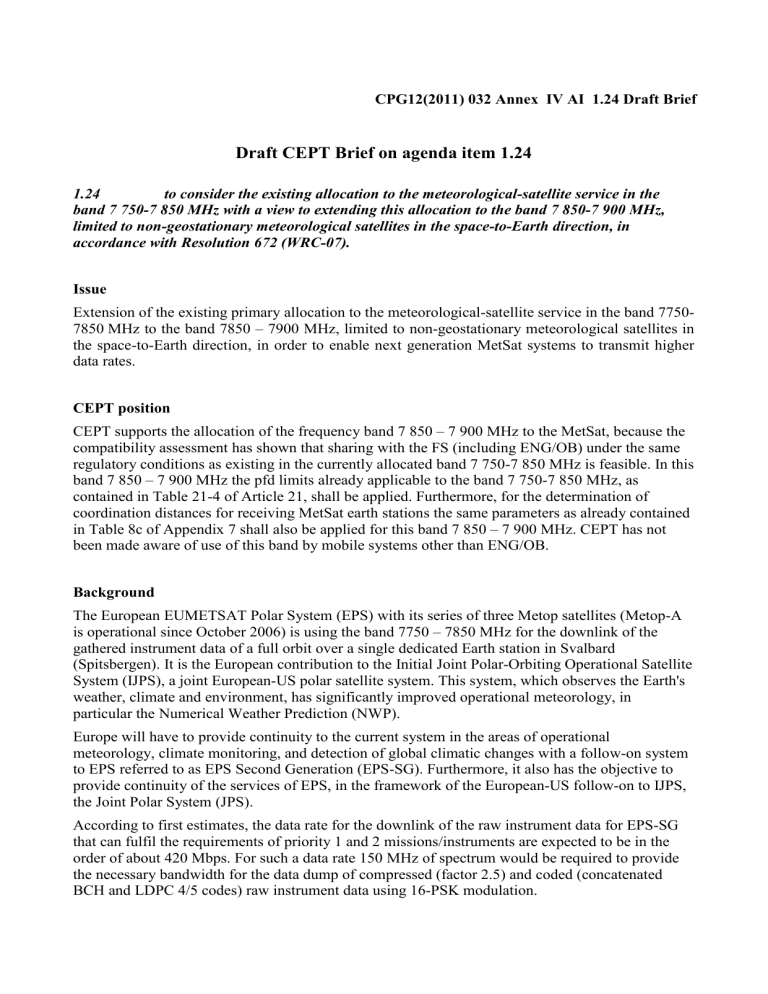
CPG12(2011) 032 Annex IV AI 1.24 Draft Brief
Draft CEPT Brief on agenda item 1.24
1.24 to consider the existing allocation to the meteorological-satellite service in the band 7 750-7 850 MHz with a view to extending this allocation to the band 7 850-7 900 MHz, limited to non-geostationary meteorological satellites in the space-to-Earth direction, in accordance with Resolution 672 (WRC-07).
Issue
Extension of the existing primary allocation to the meteorological-satellite service in the band 7750-
7850 MHz to the band 7850 – 7900 MHz, limited to non-geostationary meteorological satellites in the space-to-Earth direction, in order to enable next generation MetSat systems to transmit higher data rates.
CEPT position
CEPT supports the allocation of the frequency band 7 850 – 7 900 MHz to the MetSat, because the compatibility assessment has shown that sharing with the FS (including ENG/OB) under the same regulatory conditions as existing in the currently allocated band 7 750-7 850 MHz is feasible. In this band 7 850 – 7 900 MHz the pfd limits already applicable to the band 7 750-7 850 MHz, as contained in Table 21-4 of Article 21, shall be applied. Furthermore, for the determination of coordination distances for receiving MetSat earth stations the same parameters as already contained in Table 8c of Appendix 7 shall also be applied for this band 7 850 – 7 900 MHz. CEPT has not been made aware of use of this band by mobile systems other than ENG/OB.
Background
The European EUMETSAT Polar System (EPS) with its series of three Metop satellites (Metop-A is operational since October 2006) is using the band 7750 – 7850 MHz for the downlink of the gathered instrument data of a full orbit over a single dedicated Earth station in Svalbard
(Spitsbergen). It is the European contribution to the Initial Joint Polar-Orbiting Operational Satellite
System (IJPS), a joint European-US polar satellite system. This system, which observes the Earth's weather, climate and environment, has significantly improved operational meteorology, in particular the Numerical Weather Prediction (NWP).
Europe will have to provide continuity to the current system in the areas of operational meteorology, climate monitoring, and detection of global climatic changes with a follow-on system to EPS referred to as EPS Second Generation (EPS-SG). Furthermore, it also has the objective to provide continuity of the services of EPS, in the framework of the European-US follow-on to IJPS, the Joint Polar System (JPS).
According to first estimates, the data rate for the downlink of the raw instrument data for EPS-SG that can fulfil the requirements of priority 1 and 2 missions/instruments are expected to be in the order of about 420 Mbps. For such a data rate 150 MHz of spectrum would be required to provide the necessary bandwidth for the data dump of compressed (factor 2.5) and coded (concatenated
BCH and LDPC 4/5 codes) raw instrument data using 16-PSK modulation.
The required extension of the MetSat allocation into the band 7850 – 7900 MHz would only concern the same radiocommunication services, namely the FIXED and MOBILE (except aeronautical mobile) service, like in the band 7750 – 7850 MHz where MetSat (limited to NGSO) is already allocated on a primary basis.
Compatibility between MetSat and the fixed and mobile service was already demonstrated in preparation for WRC-97 where the allocation to the MetSat in the band 7750 – 7850 MHz was originally added to the table of allocations in Article 5 of the Radio Regulations.
In particular the interference impact on the fixed and mobile service from the downlink of a polarorbiting MetSat system like EPS-SG to its dedicated Earth station would be very limited as such an
Earth station is deployed at high northern or southern latitudes (Svalbard (Spitsbergen) or
McMurdo, Troll or O’Higgins, Antarctica) in order to avoid blind orbits in which the stored instrument data of an entire orbit cannot be received.
Studies conducted before WRC-97 concluded that more than 13 dB of margin were available to protect fixed service systems operating in European cities at high latitudes with worst case azimuths along the sub-satellite track.
For other applications such as continuous transmission of data directly to some national meteorological services (which will process the received data), the sharing situation had also to be studied. It should be noted that these national meteorological service stations may be at any latitude.
Currently there is only one system planned (NPOESS (to be replaced by JPSS) of NOAA) to operate such a type of application which requires around 30 MHz of contiguous spectrum. For another system (FY-3 from China) the dissemination of data is restricted to the territory of China.
The results of the sharing studies are contained in Report ITU-R SA.2164 on “Compatibility between the meteorological satellite and the fixed service in the band 7 850-7 900 MHz”. Regarding the potential of interference into FS receivers, the compatibility studies with non-geostationary
MetSat systems concluded that even under worst case assumptions, a positive margin of 11 dB with respect to the FDP fixed service interference criterion remains, matching well with the results of the sharing studies that were performed in preparation for WRC-97.
Considering the potential of interference of transmitting FS stations into MetSat earth station receivers, separation distances for typical constellations are in the order of 5-20 km and are generally determined by the first obstacle in the line-of-sight transmission path. Only in a line-ofsight mainbeam-to-mainbeam scenario using maximum FS EIRP density levels as contained in
Recommendation ITU-R F.758 and very worst case constellations, the separation distance can extend up to around 40-50 km.
It can be concluded that the potential extension band 7 850-7 900 MHz can be shared under the same conditions as the current allocation in the band 7 750-7 850 MHz. The current pfd limits contained in Table 21-4 of Article 21 and Table 8c of Appendix 7 for the band 7 750-7 850 MHz are adequate for proper operation of future meteorological satellite systems as well as protection of fixed service systems.
Also for ENG/OB applications potentially operated in some countries the sharing situation is not expected to be significantly different to that for FS systems.
List of relevant documents
Resolution 672 (WRC-07) – Extension of the allocation to the meteorological-satellite service in the band 7750 – 7850 MHz;
Recommendation ITU-R F.758-4 – Considerations in the development of criteria for sharing between the terrestrial fixed service and other services;
Report ITU-R SA.2164 – Compatibility between the meteorological satellite and the fixed service in the band 7 850-7 900 MHz;
CPM Report, chapter 4, pages 35 – 38.
Actions to be taken
---
Relevant information from outside CEPT
European Union
Note from Presidency to Coreper, dd 12 May 2011: the following objectives to be achieved at WRC-12 in view of the successful implementation of relevant Union policies, taking into account the Commission's Communication: to promote new allocations and protection for scientific services, in particular services helping to combat climate change and ensuring the security of citizens; to support studies on the role of Earth Observation for monitoring and predicting climate change, for disaster prediction and for understanding all aspects of climate change (WRC-12 Agenda Item
1.6/1.8/1.24/8.1.1);
Regional telecommunication organisations
APT (June 2011)
APT Members support the results of ITU-R studies invited by Resolution 672 (WRC-07) to address sharing of Metsat services with the existing and planned fixed and mobile services in the band 7 850-7 900 MHz
APT Members support to add a primary allocation to the MetSat service in the band 7 850-
7 900 MHz on a world-wide basis, limited to non-geostationary satellite systems
APT Members propose applying the pfd limits contained in RR Table 21-4 of Article 21 currently applicable to the band 7 250-7 850 MHz. In order to apply the same parameters required for the determination of coordination distances for a receiving MetSat earth station as in the already allocated band 7 750-7 850 MHz, the frequency band in Table 8c of Appendix 7 would have to be amended to also cover the band 7 850-7 900 MHz
APT Members also propose to modify the frequency band in RR No. 5.461B as a consequential change and Resolution 672 (WRC-07) should be suppressed
ATU (date of proposal)
ASMG (March 2010)
The preliminary position of ASMG is to support an additional allocation to non-geostationary meteorological satellites (s-E) in the 7 850-7 900 MHz, subject to regulatory, procedural, technical measures and conditions provided in Article 21 and Appendix 7 of the RR, similar to the ones imposed in the band 7750-7850 MHz.
CITEL (May 2011)
IAP – Argentina, Brazil, Canada, Colombia, Chile, Costa Rica, Dominican Republic, Ecuador,
USA, Guatemala, Mexico, Uruguay, Venezuela:
Support only Method in CPM report
•
MOD Article 5 to extend MetSat to 7850-7900 MHz
•
MOD footnote 5.461B
•
MOD Table 21-4
•
MOD Appendix 7 Table 8c
•
SUP Resolution 672 (WRC-07)
RCC ( April 2011)
RCC CAs do not object to allocation of the band 7850-7900 MHz to the space-Earth meteorological satellite service (limited to non-geostationary networks) on a primary basis under the following provisions:
pfd limits contained in Table 21-4 of RR Article 21 currently applicable to the band 7750-
7850 MHz shall be applied in the frequency band 7850 – 7900 MHz;
to apply the same parameters that are indicated for the frequency band 7750 – 7850 MHz for the frequency band 7850 – 7900 MHz in Table 8c of RR Appendix 7.
International organisations
NATO (May 2010)
NATO supports the allocation of this additional spectrum to the MetSat under the condition that sharing studies confirm that such an allocation would not put undue constraints on other services.
SFCG ( June 2011)
SFCG supports the single Method described in the CPM Report on WRC-12 Agenda item 1.24.
The mission requirements for next generation non-GSO meteorological satellites in terms of observations, instruments and user-services clearly show a need to transmit higher data rates compared to current systems. SFCG supports the extension of the existing allocation of the 7 750-
7 850 MHz band to the meteorological-satellite service (space-to-Earth) for use by nongeostationary satellites into the 7 850-7 900 MHz band. SFCG notes that sharing scenarios in the frequency band 7 850-7 900 MHz are similar to ones in the frequency band 7 750-7 850 MHz.
WMO (April 2011)
WMO stresses that the same services are allocated in the 7750-7850 MHz and 7850-7900 MHz bands hence justifying similar sharing conditions with the METSAT service. WMO supports the
METSAT allocation extension in the 7850-7900 MHz under the same regulatory conditions as in the 7750-7850 MHz band.
WMO supports the content of the CPM-Text and the only one method that is proposed to satisfy this agenda item, namely the inclusion of the allocation to the METSAT service in the band 7850-
7900 MHz under the same regulatory conditions as in the 7750-7850 MHz band.
Regional organisations
ESA (June 2011)
Same as SFCG position.
EUMETNET ( April 2011)
Same as WMO position.
EUMETSAT ( June 2011)
Same as WMO and SFCG.


